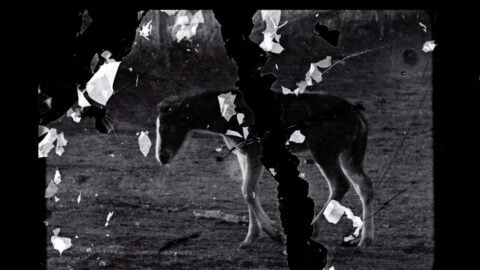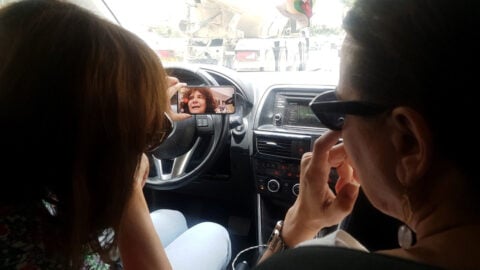Conceived in Liberty
This article appeared in the April 26, 2024 edition of The Film Comment Letter, our free weekly newsletter featuring original film criticism and writing. Sign up for the Letter here.

Civil War (Alex Garland, 2024). Photo Courtesy of A24.
Title and prerelease Reddit speculation notwithstanding, Alex Garland’s Civil War does not actually have much to say about a speculative Second American Civil War. In fact, one learns more about the film’s premise from its promotional materials than from the film itself. The multiple, conflicting maps of a newly war-torn United States—circulated by the distributor, A24, and resoundingly mocked by the online commentariat—appear nowhere in the movie.
Instead, in the opening moments, the president of the United States (Nick Offerman, speaking with an overtly Trumpian syntactical incoherence) rehearses an address to the nation that gestures at a few particulars: the “Western Forces” have apparently been menacing those loyal to the federal government. (Something called the “Florida Alliance” is, unsurprisingly, doing its own weird thing.) The country is embroiled in some sort of factional conflict that has turned an overwhelming number of its citizens into gun-crazed psychos—akin to the “rage-infected” zombies of 28 Days Later, Danny Boyle’s 2002 film whose script marked Garland’s transition from literature into cinema. The journalist heroes of the story embed with a gang of Hawaiian-shirted Boogaloo Bois; a passing reference is made to an “Antifa Massacre.” But race, class, corruption, extremist religious ideologies—such things are never mentioned. The movie shrinks from specifics, opting instead to meditate broadly on the war—or maybe just “War”: how it looks, and the role that journalists play in recording it.
The pseudo-political fuzziness is of little surprise. For many viewers, it’s perhaps a virtue and a relief. Who wants to go to the movies to talk about politics? This lack of specificity is also essential for the effective marketing of an expensive movie that wants to please everyone. Hollywood movies are designed to generate buzz, and by that measure Civil War was already a success before it opened. NPR has convened roundtables. The New York Times, in addition to its glowing review, has published at least four op-eds, two behind-the-scenes pieces, an interview with the director, and a podcast, calling the film “a terrifying premonition.” Fox News, meanwhile, has taken another tack, interviewing a data analyst to speculate on how the war will actually go down, with “various paramilitary groups and research groups . . . assert[ing] themselves as medieval lords, propped up by any advanced military hardware that they may possess.”
When cosplaying America’s downfall, vagueness is a virtue, and itself a politics, as the critic A.S. Hamrah noted about several studio tentpoles of the 2010s, including Star Wars: The Last Jedi (2017) and Avengers: Infinity War (2018): “The actual political content of these movies lies there, in this cynical desire to leverage ambiguous, implanted meaning.” Civil War takes a narrow view, focalized through the perspective of a small group of reporters as they venture through the various conflict zones between New York City and Washington, D.C. Among this cadre of barely sketched characters is Kirsten Dunst as seasoned photojournalist Lee Smith, who, together with her colleague Joel (Wagner Moura), hatches a plan to drive a circuitous, 850-mile route to the White House to interview the soon-to-be-deposed President Offerman. Inconveniently along for the ride are two new members of her team: Sammy (Stephen McKinley Henderson), a not-exactly-combat-ready veteran reporter of the written word who wears suspenders and pressed, monogrammed dress shirts; and Jessie, a budding photographer played by Cailee Spaeny. An admirer of Lee, whom she recognizes instantly (in this strange future, photojournalists are celebrities), Jessie is a “citizen journalist” armed not with a smartphone but with her dad’s 35mm Nikon camera, hoping to document the conflict in the most impractical and analog-fetishistic way possible.
Here is one of Civil War’s Big Themes: the importance of a free press in a chaotic, riven world. Unfortunately, the film has no more substantial a conception of journalism than it does of politics—there is no sense of who pays for it, where it’s published (though it’s certainly not, as Joel says, “Whatever’s left of The New York Times”), who consumes it, and how it’s received. A couple of scenes into the film, we’re holed up in a bustling hotel bar packed with the ladies and gentlemen of the press, drinking and smoking indoors. It is a time capsule of legacy media’s bygone days: gainfully employed reporters carousing and talking shop. As with 2016’s “Trump bump,” when New York Times and Washington Post subscription growth increased tenfold, democracy is dying, but not in darkness. Journalism seems a robust occupation amid this civil war—but the political and economic forces that make it so are entirely unaddressed.
The film’s other major concern, photography, is the perfect way to show—but not discuss—this political-ish atmosphere: “We record so other people ask,” Lee tells Jessie. “Wanna be a journalist? That’s the job.” The film follows Lee and her crew from one context-free conflict to another as they snap photos from the sidelines. Whether they do this for an audience of millions or for their own adrenaline rush is unclear. Mere capture is what’s important, a notion that Garland and his usual cinematographer, Rob Hardy, ram into our retinas at every opportunity. Early on, we see the president hovering in a field of lens flares and woozy soft focus; in the midst of the film’s many unremarkable battles—between random combatants we neither recognize nor care about—the action is punctuated by freeze-frames intended to show us Lee’s or Jessie’s talents for capturing the decisive moment. Lee occasionally pauses to offer Jessie mini-lessons in the art of photography, or to geek out about Jessie’s travel-size negative-developing kit. All of these attempts to score analog cred would seem charmingly dorky if the film’s own images weren’t so drab and cliché, collages of digital dystopias and real-world locations in Atlanta, where the film was shot.
This comes as something of a surprise, considering that Garland’s previous films, even at their most shallow, have provided us with a number of sleek, indelible images: think of the bunker of mirrors in Ex Machina (2014), the undulant “Shimmer” of Annihilation (2018), or the drugged-out “slo-mo” in 2012’s Dredd (on which Garland has a screenplay credit, but which he also de-facto directed, according to star Karl Urban). Civil War, on the other hand, hunts for gravitas in familiar imagery that the filmmakers don’t seem to recognize as the pure kitsch of a post-9/11 cinema that’s now over two decades old: just as when the genre was new, the filmmakers seem cynically uninterested in parsing the difference between real-world tragedy and eye-popping movie magic. Only here the latter feels shopworn. In addition to a pastiche of an American highway littered with abandoned cars, cribbed from Spielberg’s 2005 War of the Worlds (and set here to the churning electro-dirge of synth-punk outfit Suicide’s “Rocket USA”—the film seems desperate to impress the viewer with its music licensing), we also get a trailer-ready shot of the Lincoln Memorial being noisily blasted with a rocket launcher, evoking everything from Independence Day (1996) to White House Down and Olympus Has Fallen (both 2013). Obviously intended to shock, dismay, and disgust—“Not the Lincoln Memorial!”—this latter image is followed immediately by a computer-generated military helicopter swooping through the smoke, striving to convey a chilling vision of the future through digital-action spectacles that already feel like relics of the past.
As Lee and company reach the end of their journey, Garland has few moves left but the most obvious: a bloody assault on the White House that’s a galumphing, steroidal rehash of the January 6 riot. It’s left to the viewer—or the op-ed hype machine—to debate whether the film means to recast that clumsy rabble as an organized army of revolutionaries or a terrifying harbinger of things to come. The filmmakers seem to be as resigned to the pointlessness of their own exercise as Lee is disillusioned with her vocation by the end of the film. Not long after her “We record” speech, she confides to Sammy, “Every time I survived a war zone, I thought I was sending a warning home: ‘Don’t do this.’ But here we are.” It remains unclear whether Garland wants to send a warning, or fan the flames of revolution, or simply make an ambitious bid for box-office success. But here he is, blowing up the White House.
Leo Goldsmith teaches screen studies at Eugene Lang College of Liberal Arts, The New School, and serves as a programming advisor for the New York Film Festival.







